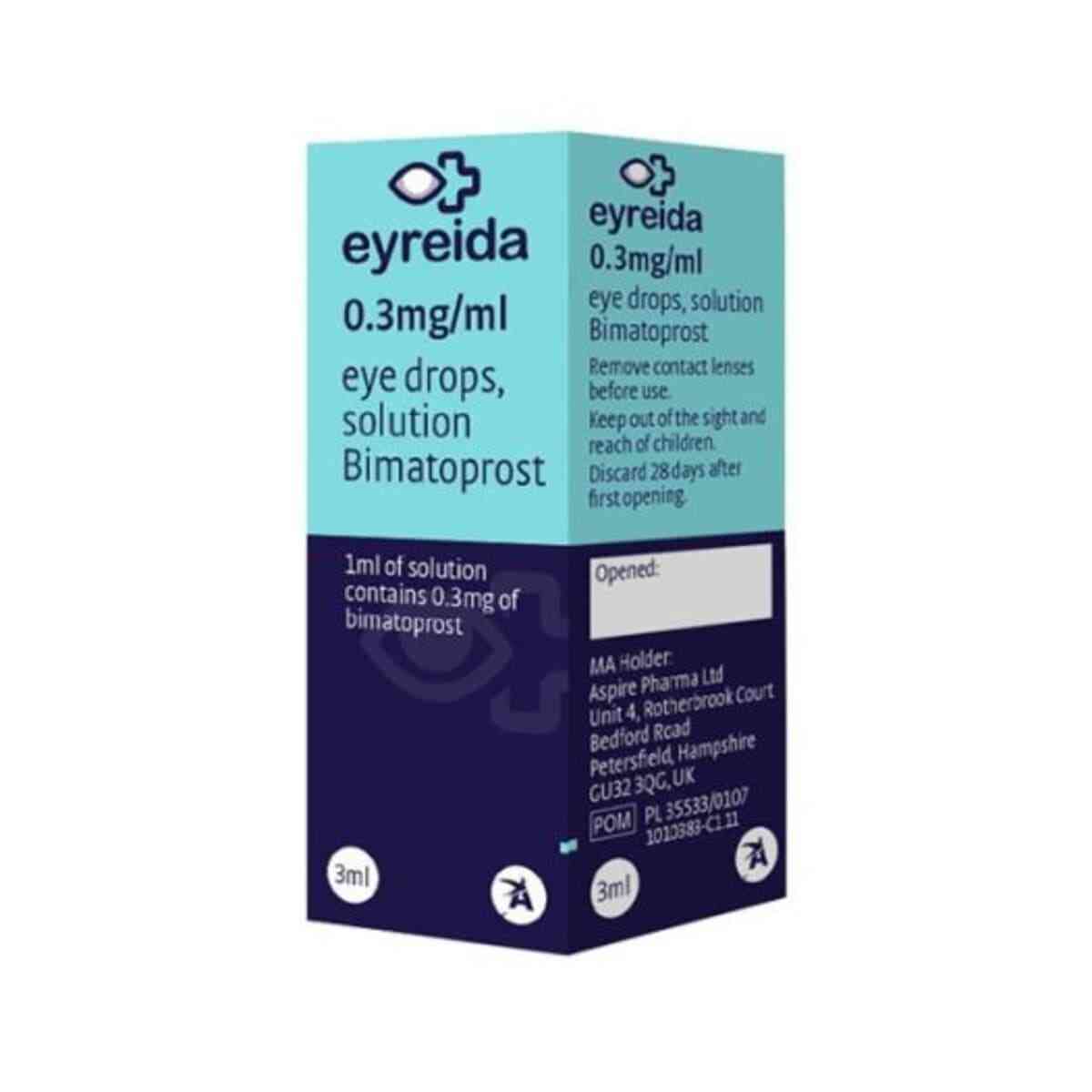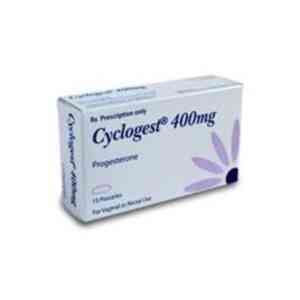- Preservative Free Eye drops
- Treatment for Glaucoma
- Active Ingredient: Bimatoprost 0.3mg/ml
Eyreida Eye Drops, 3ml
What Eyreida Eye Drops is and what it is used for
Eyreida Eye Drops is an anti-glaucoma preparation. It belongs to a group of medicines called prostamides.
Eyreida is used to reduce high pressure in the eye in adults. This medicine may be used on its own or with other drops called beta-blockers which also reduce pressure.
The active substance is Bimatoprost ( bimatoprost eye drops )
Your eye contains a clear, watery liquid that feeds the inside of the eye. Liquid is constantly being drained out of the eye and new liquid is made to replace this. If the liquid cannot drain out quickly enough, the pressure inside the eye builds up. This medicine works by increasing the amount of liquid that is drained. This reduces the pressure inside the eye. If the high pressure is not reduced, it could lead to a disease called glaucoma and eventually damage your sight.
Eyreida eye drops solution is a sterile solution that does not contain a preservative.
What is Glaucoma?
Glaucoma is a common eye condition where the optic nerve, which connects the eye to the brain, becomes damaged.
It’s usually caused by fluid building up in the front part of the eye, which increases pressure inside the eye.
Glaucoma can lead to loss of vision if it’s not diagnosed and treated early.
It can affect people of all ages, but is most common in adults in their 70s and 80s.
Glaucoma does not usually cause any symptoms to begin with.
It tends to develop slowly over many years and affects the edges of your vision (peripheral vision) first.
For this reason, many people do not realise they have glaucoma, and it’s often only picked up during a routine eye test.
If you do notice any symptoms, they might include blurred vision, or seeing rainbow-coloured circles around bright lights.
Both eyes are usually affected, although it may be worse in 1 eye.
Very occasionally, glaucoma can develop suddenly and cause:
Visit an opticians or a GP if you have any concerns about your vision.
If you have glaucoma, early diagnosis and treatment can help stop your vision getting worse.
Without treatment, glaucoma can eventually lead to blindness.
If you develop symptoms of glaucoma suddenly, go to your nearest eye casualty unit or A&E as soon as possible.
This is a medical emergency that may require immediate treatment.
There are several different types of glaucoma.
The most common is called primary open angle glaucoma. This tends to develop slowly over many years.
It’s caused by the drainage channels in the eye becoming gradually clogged over time.
Other types of glaucoma include:
- acute angle closure glaucoma – an uncommon type caused by the drainage in the eye becoming suddenly blocked, which can raise the pressure inside the eye very quickly
- secondary glaucoma – caused by an underlying eye condition, such as inflammation of the eye (uveitis)
- childhood glaucoma (congenital glaucoma) – a rare type that occurs in very young children, caused by an abnormality of the eye
Glaucoma can occur for a number of reasons.
Most cases are caused by a build-up of pressure in the eye when fluid is unable to drain properly.
This increase in pressure then damages the nerve that connects the eye to the brain (optic nerve).
It’s often unclear why this happens, although certain things can increase the risk, including:
- your age – glaucoma becomes more common as you get older
- your ethnicity – people of African, Caribbean or Asian origin are at a higher risk
- your family history – you’re more likely to develop glaucoma if you have a parent or sibling with the condition
- other medical conditions – such as short-sightedness, long-sightedness and diabetes
It’s not clear whether you can do anything to prevent glaucoma, but having regular eye tests should pick it up as early as possible.
The treatment recommended for you will depend on the type of glaucoma you have, but the options are:
- eyedrops – to reduce the pressure in your eyes
- laser treatment – to open up the blocked drainage tubes or reduce the production of fluid in your eyes
- surgery – to improve the drainage of fluid
You’ll also probably need regular appointments to monitor your condition and check the treatment is working.
Further Information on Glaucoma
Eyreida Eye Drops Reviews
After using Eyreida Eye Drops, it’s helpful to let others know about your experience. Reviews of an item help other users know that medicines received have helped the condition it is claimed for, how well the treatment worked or any issues to be aware of. We invite our users to leave a review of both their treatment and of the service provided. Click on the reviews tab to see if there has been feedback on this item.
Price of Eyreida Eye Drops in UK
Where to buy Eyreida Eye Drops
Eyreida Eye Drops is available to buy with a prescription at Dock Pharmacy Essex UK, UK Online Pharmacy.
Brand
Eyreida
How To Use
How to use Eyreida
Always use this medicine exactly as your doctor or pharmacist has told you. Check with your doctor or pharmacist if you are not sure.
The recommended dose is one drop in the evening, once daily in each eye that needs treatment. Eyreida should only be applied to the eye.
If you use Eyreida with another eye medicine, wait at least 5 minutes between using Eyreida and the other eye medicine. Use any eye ointment or eye gel last.
Do not use more than once a day as the effectiveness of treatment may be reduced.
Do not allow the tip of the multi-dose container to touch the eye or areas around the eye. It could cause injury to your eye. The eye drops solution may become contaminated with bacteria that can cause eye infections leading to serious damage of the eye, even loss of vision.
To avoid possible contamination of the multi-dose container, keep the tip of the multi-dose container away from contact with any surface.
Instructions for use
Before instillation of the eye drops:
- Wash your hands before opening the bottle.
- Do not use this medicine if you notice that the tamper-proof seal on the bottle neck is broken before you first use it.
- At the first use, after cap removal, without positioning the eyedropper above the eye, slowly squeeze the bottle to deliver one drop in the air to get used to the pressure and time required to deliver one drop. In case of difficulties of delivering one drop at a time, this step might be repeated.
- Choose the position that you find most comfortable for the instillation of the drops (you can sit down, lie on your back, or stand in front of a mirror).
Instillation:
1. Hold the bottle directly below the cap and turn the cap to open the bottle. Do not touch anything with the tip of the bottle to avoid contamination of the solution.
2. Tilt your head backwards and hold the bottle above your eye.
3. Pull the lower eyelid down and look up. Squeeze the bottle gently in the middle and let a drop fall into your eye. Please note that there might be a few seconds delay between squeezing and the drop coming out. Do not squeeze too hard.
If you are not sure how to administer your medicine, ask your doctor or pharmacist.
4. Blink a few times so that the drop spreads over the eye.
5. Repeat the instructions 2. – 4. to deliver a drop into the other eye also, if your doctor has instructed you to do this. Sometimes only one eye needs to be treated and your doctor will advise if this applies to you and which eye needs treatment.
6. After use and prior to recapping, the bottle should be shaken once in a downwards direction, without touching the dropper tip, in order to remove any residual liquid on the tip. This is necessary in order to ensure delivery of subsequent drops.
7. After you have used all doses there will be some Eyreida left in the bottle. You should not be concerned since an extra amount of Eyreida has been added and you will get the full amount of Eyreida that your doctor has prescribed. Do not attempt to use the excess medicine remaining in the bottle after you have completed the course of treatment.
Do not use the eye drops for longer than 28 days after first opening the bottle.
Always use this medicine exactly as described in this leaflet or as your doctor or pharmacist has told you. Check with your doctor or pharmacist if you are not sure.
If you use more Eyreida than you should:
If you use more of this medicine than you should, it is unlikely to cause you any serious harm. Put your next dose in at the usual time. If you are worried, talk to your doctor or pharmacist.
If you forget to use Eyreida:
If you forget to use this medicine, use a single drop as soon as you remember, and then go back to your regular routine. Do not take a double dose to make up for a forgotten dose.
If you stop using Eyreida:
Eyreida should be used every day to work properly. If you stop using Bimatoprost 0.3mg/ml eye drops solution the pressure inside your eye may go up, therefore talk to your doctor before stopping this treatment.
If you have any further questions on the use of this medicine, ask your doctor or pharmacist.
Product Details
What you need to know before you use Eyreida
Do not use Eyreida:
- if you are allergic to bimatoprost or any of the other ingredients of this medicine (listed in section 6).
Warnings and precautions
Talk to your doctor or pharmacist before using Eyreida.
Please tell your doctor or pharmacist, if:
- you have any breathing problems.
- you have liver or kidney problems.
- you have had a cataract surgery in the past.
- you have or have had low blood pressure or low heart rate.
- you have had a viral infection or inflammation of the eye.
Eyreida may cause your eyelashes to darken and grow, and cause the skin around the eyelid to darken too. The colour of your iris may also go darker over time. These changes may be permanent. The change may be more noticeable if you are only treating one eye.
If you have a history of contact hypersensitivity to silver, you should not use this product as dispensed drops may contain traces of silver.
Children and adolescents
Eyreida has not been tested in children under the age of 18 and therefore should not be used by patients under 18 years.
Other medicines and Eyreida
Tell your doctor or pharmacist if you are taking, have recently taken or might take any other medicines.
Pregnancy, breast-feeding and fertility
If you are pregnant or breast-feeding, think you may be pregnant or are planning to have a baby, ask your doctor or pharmacist for advice before taking this medicine.
Bimatoprost may get into breast milk, so you should not breast-feed while you are taking this medicine.
Driving and using machines
Your sight may become blurred for a short time just after using Eyreida. You should not drive or use machines until your sight is clear again.
Side Effects
Possible side effects
Like all medicines, this medicine can cause side effects, although not everybody gets them.
If you get any side effects, talk to your doctor or pharmacist. This includes any possible side effects not listed in this leaflet.
Very common: may affect more than 1 in 10 people
- Slight redness of the eye
Common: may affect up to 1 in 10 people
- Small breaks in the surface of the eye, with or without inflammation
- Irritation of the eye
- Itchy eyes
- Eye pain
- Dry eyes
- A feeling that something is in your eye
- Longer eyelashes
- Darker skin colour around the eye
- Red eyelids
Uncommon: may affect up to 1 in 100 people
- Tired eyes
- Sensitivity to light
- Darker iris colour
- Itchy and swollen eyelids
- Tears
- Swelling of the see-through layer which covers the surface of the eye
- Blurred vision
- Headaches
- Hair growth around the eye
Not known: frequency cannot be estimated from the available data
- Asthma
- Worsening of asthma
- Worsening of the lung disease called chronic obstructive pulmonary disease (COPD)
- Shortness of breath
- Symptoms of allergic reaction (swelling, redness of the eye and rash of the skin)
- Ocular discomfort
- Skin discoloration (periocular)
In addition to the side effects for Eyreida, the following side effects have been seen with the preserved multi-dose formulation of Bimatoprost 0.3 mg/ml and may occur in patients taking Eyreida:
- Dizziness
- Burning sensation in the eye
- An allergic reaction in the eye
- Inflamed eyelids
- Difficulty in seeing clearly
- Sticky eyes
- Worsening vision
- Darker eyelashes
- Retinal bleeding
- Inflammation within the eye
- Cystoid macular oedema (swelling of the retina within the eye leading to worsening vision)
- Iris inflammation
- Eyelid twitching
- Eyelid shrinking, moving away from surface of the eye
- Eyes appear sunken
- Increased blood pressure
- Nausea
- Skin redness around the eye
- Weakness
- An increase in blood-test results that show how your liver is working
Other side effects reported with eye drops containing phosphates
In very rare cases, some patients with severe damage to the clear layer at the front of the eye (the cornea) have developed cloudy patches on the cornea due to calcium build-up during treatment.
Reporting of side effects
If you get any side effects, talk to your doctor, pharmacist or nurse. This includes any possible side effects not listed in this leaflet. You can also report side effects directly via the Yellow Card Scheme (website: www.mhra.gov.uk/yellowcard). By reporting side effects you can help provide more information on the safety of this medicine.
Ingredients
What Eyreida contains
- The active substance is Bimatoprost.
- The other ingredients are: sodium chloride, disodium hydrogen phosphate heptahydrate, citric acid monohydrate, sodium hydroxide or hydrochloric acid (for pH adjustment), water for injections.
Questions and answers of the customers
There are no questions yet, be the first to ask something for this product.
Other Products From This Seller
Original price was: £31.00.£10.95Current price is: £10.95.
Chopard Wish Eau de Parfum 30ml Sweet and Oriental Fragrance for Women Indulge in elegance with Chopard Wish Eau de Parfum, 30ml, a sweet and oriental fragrance for women that exudes sophistication and charm. This luxurious scent by Chopard is inspired by the allure of wishes and dreams, blending warm and sensual notes for a […]
Learn MoreOriginal price was: £31.00.£10.95Current price is: £10.95.
- Availability: in stock
Original price was: £84.00.£26.95Current price is: £26.95.
Vera Wang Lovestruck Eau de Parfum 100ml Romantic Floral and Feminine Fragrance Celebrate romance and femininity with Vera Wang Lovestruck Eau de Parfum, 100ml, a romantic floral fragrance for women inspired by love at first sight. This enchanting scent captures the essence of passion and charm with a blend of delicate florals and sweet fruity […]
Learn MoreOriginal price was: £84.00.£26.95Current price is: £26.95.
- Availability: in stock
Original price was: £25.00.£9.95Current price is: £9.95.
Gloria Vanderbilt Vanderbilt EDT Spray, 100ml Timeless Floral Elegance Embrace timeless elegance with Gloria Vanderbilt Vanderbilt Eau De Toilette Spray, 100ml, a sophisticated floral fragrance for women that captures grace, femininity, and charm. Designed for confident and classic women, this iconic scent by Gloria Vanderbilt combines delicate floral notes with warm undertones for a long-lasting […]
Learn MoreOriginal price was: £25.00.£9.95Current price is: £9.95.
- Availability: in stock
Original price was: £34.00.£15.95Current price is: £15.95.
Elizabeth Arden Splendor Eau De Parfum, 125 ml Sophisticated Floral Fragrance Indulge in timeless elegance with Elizabeth Arden Splendor Eau De Parfum, 125ml, a sophisticated floral fragrance for women that exudes grace and charm. Inspired by moments of pure splendor, this iconic scent by Elizabeth Arden combines floral and woody notes for a captivating and […]
Learn MoreOriginal price was: £34.00.£15.95Current price is: £15.95.
- Availability: in stock
Original price was: £44.00.£19.95Current price is: £19.95.
Elizabeth Arden Red Door Eau De Toilette Spray 50ml Timeless Floral Elegance Step into timeless elegance with Elizabeth Arden Red Door Eau De Toilette Spray, 50ml, a classic floral fragrance for women that has become an icon of sophistication. Inspired by the legendary Red Door Spa, this luxurious scent captures the essence of femininity with […]
Learn MoreOriginal price was: £44.00.£19.95Current price is: £19.95.
- Availability: in stock
Original price was: £55.00.£19.95Current price is: £19.95.
Estee Lauder Pleasures EDP 30ml Fresh and Floral Fragrance for Women Experience the timeless elegance of Estee Lauder Pleasures Eau de Parfum, 30ml, a fresh and floral fragrance for women that captures the beauty of life’s simplest pleasures. This classic scent by Estee Lauder is designed for modern, sophisticated women who appreciate light, airy fragrances. […]
Learn MoreOriginal price was: £55.00.£19.95Current price is: £19.95.
- Availability: in stock
Original price was: £34.99.£19.95Current price is: £19.95.
Sarah Jessica Parker Lovely You Eau de Parfum Spray 100ml Sophisticated Floral and Musky Fragrance Step into timeless elegance with Sarah Jessica Parker Lovely You Eau de Parfum Spray, 100ml, a floral and musky fragrance for women that embodies sophistication and modernity. Created by Sarah Jessica Parker, this iconic scent celebrates femininity with a delicate […]
Learn MoreOriginal price was: £34.99.£19.95Current price is: £19.95.
- Availability: in stock
Original price was: £47.00.£29.95Current price is: £29.95.
Kenzo Flower Eau De Toilette Spray 30ml Fresh and Floral Fragrance for Women Experience the delicate beauty of nature with Kenzo Flower Eau De Toilette Spray, 30ml, a fresh and floral fragrance for women inspired by the elegance of the red poppy. This iconic scent combines floral and powdery notes to create a delicate and […]
Learn MoreOriginal price was: £47.00.£29.95Current price is: £29.95.
- Availability: in stock
Original price was: £47.00.£29.95Current price is: £29.95.
Jimmy Choo Eau de Parfum 40ml Sweet and Floral Fragrance for Women Step into a world of luxury and confidence with Jimmy Choo Eau de Parfum, 40ml, a sweet and floral fragrance for women that embodies modern glamour. Designed for women who exude confidence and style, this Jimmy Choo perfume for women blends fruity and […]
Learn MoreOriginal price was: £47.00.£29.95Current price is: £29.95.
- Availability: in stock
Original price was: £52.00.£23.95Current price is: £23.95.
Issey Miyake L’Eau d’Issey Pure Nectar Eau de Parfum Spray, 30ml Floral and Aquatic Elegance Discover the purity of nature with Issey Miyake L’Eau d’Issey Pure Nectar Eau de Parfum Spray, 30ml, a floral and aquatic fragrance for women that encapsulates elegance and sophistication. This Issey Miyake perfume for women combines fresh and delicate notes […]
Learn MoreOriginal price was: £52.00.£23.95Current price is: £23.95.
- Availability: in stock














